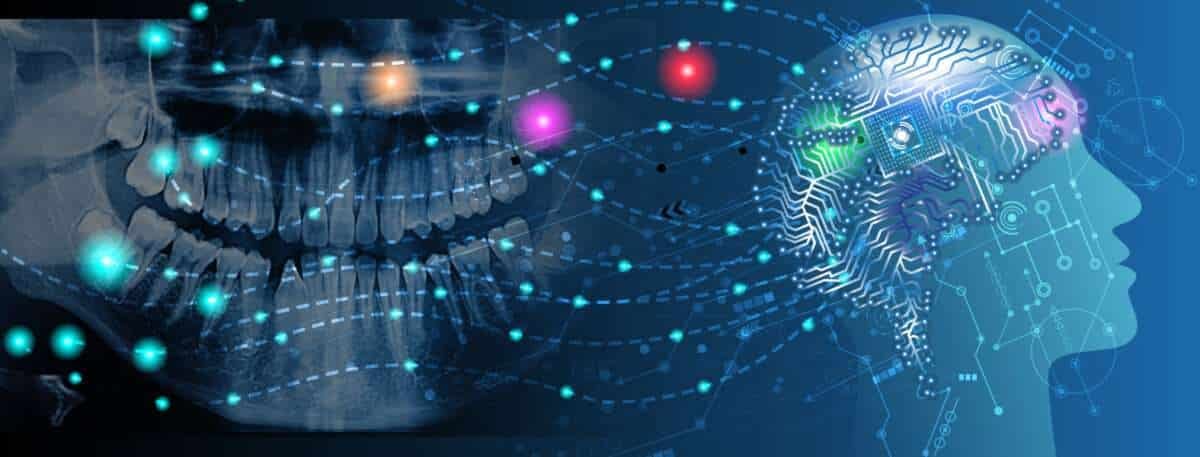AI Revolution in Dentistry: Embracing the Future of Dental Care and Practice Management
May 4th, 2023
4 min. read

By Dr. David Ahearn, DDS, Founder and President of Design Ergonomics.
and David Meerman Scott, marketing strategist and bestselling author.
The launch of the iPhone 1 in the summer of 2007 was memorable for both of us, because once we got our hands on this revolutionary device, we recognized that our worlds had changed forever. This little computer in our pockets instantly became a phone, calendar, clock, address book, web browser, email device, and more!

1st generation iPhone
Soon every industry, including dentistry, was transformed forever by the smartphone. Just think about how you and your patients use smartphones today. Patients find your practice on a Google search on their phone, get a map to your office on their phone, and read a review on Facebook about you on their phone. If they email or text you from their phone, your staff can respond instantly, no matter where they are with their smartphones.
Now dentistry is changing again, forever, because of Artificial Intelligence tools. If you’re not an early technology adopter, perhaps waiting for a later smartphone model, it will just be a matter of time. You will be using AI in many aspects of your practice from diagnosis to treatment planning and patient engagement.
Here at Design Ergonomics and at our own dental practice Perfect Smiles, the team has been working with our friend David Meerman Scott to experiment with AI in earnest. For example, we recently built a proprietary database of thousands of communications with clients over several decades. We put it behind our secure company firewall, and installed a tool built by an AI technology company to access the data with the ChatGPT interface from Open AI. This allows our customer service team to instantly find answers to client questions using natural language queries, making our responses faster and more accurate.
When we decided to write this blog post,  we went to ChatGPT and asked for suggestions on how AI is being used in dentistry to gather our thoughts. And once this post was nearly done, ChatGPT suggested the headline, saving us time! Yes, AI is now an important aspect of how we both communicate.
we went to ChatGPT and asked for suggestions on how AI is being used in dentistry to gather our thoughts. And once this post was nearly done, ChatGPT suggested the headline, saving us time! Yes, AI is now an important aspect of how we both communicate.
Here are a few thoughts on the influence of AI on dentistry right now and how it is reshaping our field for the better.
Early detection and diagnosis:
One of the most significant impacts of AI in dentistry is its ability to detect and diagnose dental issues at an early stage. Machine learning algorithms analyze dental images and X-rays to identify potential problems, such as cavities, gum diseases, and oral cancer, with exceptional precision.
By catching these issues early on, dentists can intervene before they escalate, potentially saving patients from more invasive procedures and promoting better overall oral health.
Treatment planning and personalized care:
 AI-driven tools are enabling dentists to create more accurate and personalized treatment plans. By analyzing vast amounts of patient data, these tools can identify trends and patterns, and suggest the most effective treatment options based on a patient's unique needs. This level of personalization leads to better patient outcomes and a more efficient use of resources, as treatment plans can be tailored to address the root cause of the issue.
AI-driven tools are enabling dentists to create more accurate and personalized treatment plans. By analyzing vast amounts of patient data, these tools can identify trends and patterns, and suggest the most effective treatment options based on a patient's unique needs. This level of personalization leads to better patient outcomes and a more efficient use of resources, as treatment plans can be tailored to address the root cause of the issue.
In addition, the use of AI has the prospect to actually increase case acceptance through data-based legitimization of a proposed plan. As the technology advances we anticipate that it will become possible to project and make visible outcomes that will be probable in the absence of care.
Robotic-assisted dental procedures:
While robotic-assisted dental procedures are still in their infancy, and there will undoubtedly be significant resistance to machine treatment for invasive procedures for conscious patients, AI advancements have made them a possibility.
Robots can perform specific dental tasks with a high level of accuracy and consistency, such as dental implant placement and orthodontic wire bending. These AI-powered robots can help reduce human error, streamline procedures, and potentially minimize patient discomfort during treatments.
Enhanced patient experience:
AI is already beginning to play a significant role in improving patient experience in dental practices. Chatbots and virtual assistants are always available 24/7 to help patients schedule appointments, answer questions, and provide reminders for follow-ups and dental care routines.
This level of engagement not only improves patient satisfaction but also helps in better adherence to dental care recommendations, ultimately leading to improved oral health.
Dental education and training:
Perhaps the greatest opportunity for the use of AI in dentistry will be in dental education where AI is already making significant inroads. Virtual reality and augmented reality applications, powered by AI, are now being used to simulate various dental procedures. This technology allows dental students to practice procedures in a controlled environment, reducing the learning curve and ensuring they are well-prepared for real-world scenarios.
Given the current shortage of qualified dental educators and the difficulty for many schools to obtain a sufficient flow of new patients with specific dental needs, this capability will both close the educator gap and greatly improve the students’ ability to practice a given procedure dozens or even hundreds of times.
Get started today
The sooner you learn about AI, the faster you can apply these emerging tools to your own practice. Just like the rise of the smartphone and social media like Facebook more than fifteen years ago, AI technologies will be important technologies for all of us. I understand that for some people there is a fear of change, a fear of the unknown. It’s like anything new, including your first smartphone. Just play around to start, get familiar with available tools, and prepare for the introduction of them in your practice.
The integration of AI in the dental industry is revolutionizing the way dentists diagnose and treat patients. As technology continues to advance, we can expect further improvements in the quality and efficiency of dental care, ultimately benefiting both patients and practitioners alike.
YOU MAY ALSO BE INTERESTED IN:
Automation And Robotics In The Dental Industry And At Design Ergonomics
“Why should people have to do jobs that machines can do?” asks Dr. David Ahearn, DDS, founder and President of Design Ergonomics and Ergonomic Products. “Many people haven’t been given enough chance to think creatively, but that is what humans excel at. We have a choice to either teach people to do jobs which are replaceable or to become better thinkers, which has tremendous potential value in increasing the quality of their lives. When given the choice I’ll always pursue the latter!” Read more
With over three decades of expertise in cosmetic and restorative dentistry, Dr. David Ahearn is a nationally recognized leader, educator, and innovator. His passion for cutting-edge technology and exceptional patient care is the driving force behind everything we do. As the founder of Design Ergonomics and Ergonomic Products, Dr. Ahearn has dedicated his career to designing, equipping, and training North America's most efficient and productive dental offices. His proven strategies help hundreds of practices reduce stress, boost productivity, and build sustainable, scalable growth each year. A speaker and educator, Dr. Ahearn continues to shape the future of dentistry, empowering thousands of dentists to transform their practices, improve the quality of life for their teams and families, and deliver outstanding care to their communities.